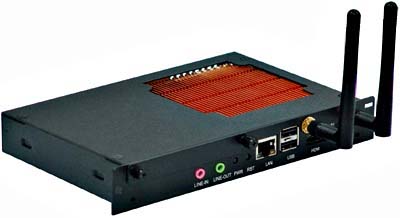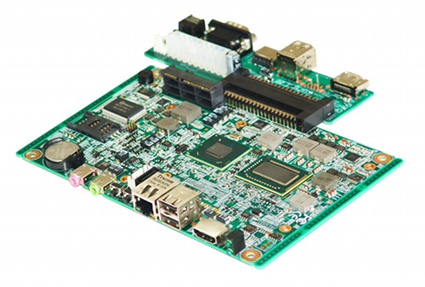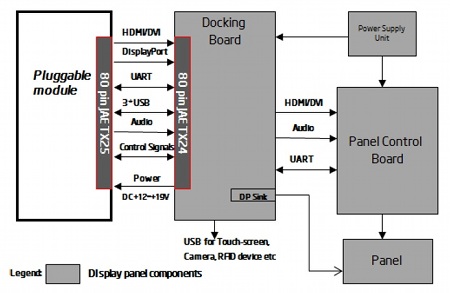Fanless signage module sports Core i7 processor
Aug 26, 2011 — by LinuxDevices Staff — from the LinuxDevices Archive — 23 viewsNorco unveiled a computing module that complies with Intel's Open Pluggable Specification (OPS) for digital signs and sports an Intel Core i7-2665LE processor. Designed to slot into the back of a signage display, the BIS-6330 accepts up to 4GB of memory, has a gigabit Ethernet port and two USB 2.0 ports, and includes a Mini PCI Express slot, the company says.
Last year, Intel announced its Open Pluggable Specification (OPS), a standardized design for digital signage PCs that fit into slots on the back of displays. At the time, not much information was revealed publicly, but the chipmaker said the OPS would involve the use of its Core processors along with Microsoft's Windows Embedded Standard operating system.
Frankly, we'd assumed that OPS — see later in this story for background — wouldn't go far, especially if it was subject to Wintel restraints. But a surprising number of compliant modules have now appeared, some from display specialists such as NEC (the SB-02SC), and others from generalists such as Axiomtek (the OPS860). NEC's entry even employs an AMD processor and supports Linux.
Now, Norco has joined in with an OPS module that uses Intel's "Sandy Bridge" Core i7-2665LE, a processor featuring dual cores, a 2.2GHz clock speed, 2.9GHz turbo frequency, and a 25-Watt TDP. The CPU is paired with the QM67 Express chipset and one SO-DIMM slot, allowing installation of up to 4GB of RAM, according to the company.

Norco's BIS-6330
Some OPS modules have made room for 2.5-inch hard disk drives in their 7.1 x 4.7 x 1.2-inch frames, but Norco's BIS-6330 (above) apparently doesn't. Instead, the company lists just a Mini PCI Express expansion slot, intended to accept a SSD (solid state disk).
The BIS-6330 product page also makes reference to "external pluggable hard disk trays," but since the company didn't make a data sheet available, we're unable to say how these would attach to the module once it has been placed inside a display. Norco did note that the module is built around a previously released, EPIC-format motherboard, the OPS-4920.
The image below shows the coastline of the OPS-4920, whose ports are carried over directly to the BIS-6330. They include audio (line in and line out), a gigabit Ethernet port, two USB 2.0 ports, and an HDMI port.

Norco's OPS-4920 board is used in the BIS-6330, but without the daughterboard pictured at top right
(Click to enlarge)
Also shown above is a daughterboard that's apparently included with the OPS-4920 when it's sold separately. The additional real-world ports this component provides aren't relevant to the BIS-6330, but the image does give you a good view of the motherboard's OPS connector.
Intel has touted fanless operation for OPS devices, and Norco confirms that the BIS-6330 is passively cooled. It may be operated in temperatures from 32 to 140 deg. F. and consumes a maximum of 35 Watts, the company adds.
Specifications listed by Norco for the BIS-6330 include:
- Processor — Core i7-2665LE (dual cores, a 2.2GHz clock speed, 2.9GHz turbo frequency, and 25-Watt TDP)
- Memory — up to 4GB of DDR3 RAM via single SODIMM
- Expansion — Mini PCI Express slot
- Networking — gigabit Ethernet port
- Standard I/O:
- 2 x USB 2.0
- HDMI
- audio (line in, line out)
- OPS connector I/O:
- 3 x USB 2.0
- 2 x SATA
- 2 x serial (1 x RS232, 1 x RS232/422/485)
- DisplayPort
- PS/2
- Power — 7~19VDC, max. 30 Watts
- Operating temperature — 32 to 140 deg. F (0 to 60 deg. C) with 0.7m/s airflow (OPS requirement)
- Dimensions — 7.1 x 4.7 x 1.2 inches (180 x 120 x 30mm); front-panel bracket adds 0.8 inches (20mm) width
Background on the Open Pluggable Specification
As we've mentioned, Intel didn't reveal much about the Open Pluggable Specification when it was first announced last October. A December blog entry clarified matters as follows, however.
According to the posting, OPS defines a standardized module and related interconnections "to insure compatibility and ease of integration between digital signage components from multiple vendors." As shown below, the standard specifies an off-the-shelf 80-pin JAE Electronics TX24/TX25 blind mate plug and receptacle connector system to interface the pluggable module and the display.

A diagam of Intel's Open Pluggable Specification
(Click to enlarge)
The pluggable module itself consists of a printed circuit computing board housed in a protective wrapper chassis, Intel adds. The circuit board should be equal to or smaller than the EPIC (Embedded Platform for Industrial Computing) standard size of 115 x 165mm, and the overall dimension of the module including the front panel "wings" is 7.8 x 4.7 x 1.2 inches (200 x 119 x 30mm), the company says.
It's said the OPS standard also defines the interface signals for all 80 pins of the JAE connector. For example, power input is specified as 12~19V DC at less than 4A and is spread over multiple pins to stay within the connector's maximum current rating. Other pins carry the digital signals for interface to the display, including HDMI, DVI, DisplayPort, audio, serial, plus provision for both USB 2.0 and USB 3.0, according to Intel.
According to Intel, the OPS standard also includes thermal specifications and details cooling requirements for modules based on the Core i7 processor and QM57 chipset. The company adds, "Although it is not required by the specification, installing digital signage equipment based on Intel architecture helps you implement scalable digital signage applications that can network easily with other equipment."
Further information
Norco did not detail pricing or operating system support for the BIS-6330. More information may be found on the BIS-6330 product page
Jonathan Angel can be reached at [email protected] and followed at www.twitter.com/gadgetsense.
This article was originally published on LinuxDevices.com and has been donated to the open source community by QuinStreet Inc. Please visit LinuxToday.com for up-to-date news and articles about Linux and open source.